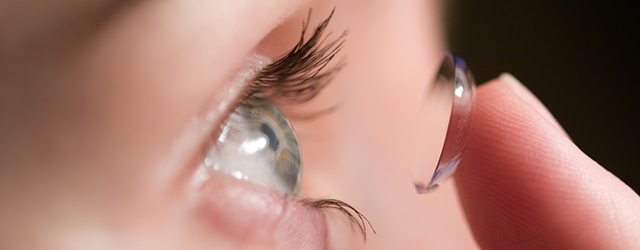Contact Lens Care

Contact lens care is a major responsibility for eye care practitioners. At least twenty-five percent of all patients who require refractive correction use contact lenses. In the past thirty years there has been an explosion in contact lens technology. A significant amount of knowledge is necessary to understand and fit the many available lens types and systems. Today, children and senior citizens are being fitted with contact lenses. There is no age barrier. Dr. Kaden is an expert contact lens practitioner who brings his expertise in corneal health to the benefit of his contact lens wearing patients.
The first description of a contact lens dates to 1845 and was written by the English astronomer John Frederick William Herschell. In 1886, Xavier Galezowski created the first therapeutic contact lens soaked in a solution of mercuric chloride and cocaine hydrochloride. This lens was used to reduce infection following cataract surgery. In 1888, Kalt in France developed the first contact lens for treatment of kerataconus. In the early twentieth century, two German companies, Carl Zeiss and Muller, became well known for production of glass corneoscleral lenses. In the 1930s, PMMA was introduced as a material for contact lenses, having the advantage of being much lighter than glass. The modern age of contact lenses began with the patenting of a PMMA corneal lens design by the American Kevin Tuohy in 1948. In the 1950s, polymerized hydroxyethylmethacrylate (HEMA), a soft material, became available along with a spin-casting manufacturing process . Bausch and Lomb obtained the patent for this process in 1966 and proceeded to mass produce soft lenses.
Modern contact lenses fall principally into two categories: soft lenses produced from a variety of hydrogel materials and rigid gas permeable lenses made of materials such as CAB, silicone acrylate, and fluorocarbons. Soft lenses are the market leader today, and are primarily prescribed with a plan for frequent replacement, either monthly, bi-weekly, or daily. The advantages of frequent planned replacement include ease of care and a lessened incidence of infections and inflammatory reactions. Frequent lens exchange relieves the need for intensive lens cleaning regimens that were a regular part of contact lens wear years ago. For most soft lens wearers a single multipurpose cleaning/disinfecting solution is adequate. Patients wearing daily replacement lenses use no solutions at all. Rigid gas permeable lenses are favored for patients with high levels of astigmatism or kerataconus. The advantages of these lenses include high quality of vision, durability, deposit resistance, high oxygen permeability, and lower costs. Rigid lenses provide better vision for patients with irregular corneas as a result of astigmatism, kerataconus, corneal scars, and corneal grafts.
The contact lens fitting process begins with taking a complete ocular and medical history followed by refraction and complete eye examination. A patient's history will include review of current medications, systemic disorders( e.g., diabetes, arthritis, thyroid disease), ocular history, and previous contact lens experience. Care is taken during the examination to look for corneal and conjunctival disease, and evidence of dry eyes or meibomian gland dysfunction. The tear film will be assessed during the examination to ensure its adequacy for contact lens wear. Based on these findings the doctor will make a recommendation as to the most appropriate type of contact lenses for each patient. Patients are then evaluated with trial contact lenses placed on their eyes. The quality of their vision is measured and the "fit" of the lenses on the ocular surface is assessed. Instruction is given to all new contact lens wearers regarding placement and removal of lenses, and daily lens care. Patients generally leave the fitting visit with trial lenses in their prescriptive power and a prescription allowing for future purchase of replacement lenses.
For more information about Contact Lens Care, or to schedule an appointment, please complete our online form or call (973) 328-6622.





